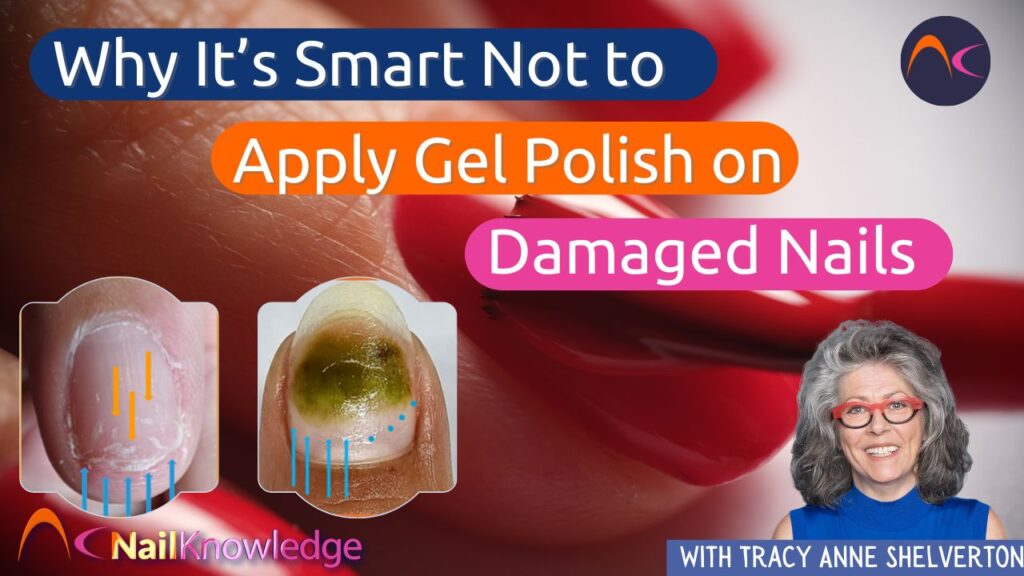Comprender los riesgos de volver a aplicar el recubrimiento de uñas sin permitir una recuperación adecuada
When your nails are damaged, it’s essential to let the nail plate recover before reapplying any nail coating. Failing to do so can lead to complications, making it important to choose the best plan of action for nail health and appearance.
Visualizar el impacto: Antes y después
Antes: Normal nail coating after about 10 days, featuring one layer of a Builder Gel for shine and a bit of stability.

Después: All Builder In A Bottle arrancó la placa de la uña junto con el borde libre de la misma.

La importancia de sellar la placa ungueal
If we look at photo 2 and the yellow arrows, we need first to seal the upper layers of the nail plate before applying more Gel Polish, and if we cannot do that a more permanent base coat will need to be applied, if we don’t do this we will create pockets for air, moisture or both under our gel polish
- Air – causes lifting

These pockets can trap various contaminants your nails come into contact with, such as dirt, bacteria, and moisture. If caught early, the product can be removed and replaced to prevent issues. However, if not addressed, trapped moisture can create an ideal breeding ground for opportunistic pathogens like Pseudomonas aeruginosa, leading to potential infections.

¿Qué podemos hacer para evitar que surjan problemas?
Accidents happen, we can’t prevent those but our clients can help with good maintenance of their nail enhancements. A good quality oil helps prevent a build up of moisture and also helps to keep your nail and nail coating flexible and less prone to breaking or cracking, so a win win for your client but also for your salon, longer lasting gorgeous nails and happier clients.
¿Se puede recuperar la placa ungueal?
Podemos, hay un producto especial en el mercado hoy en día que está disponible en todo el mundo, tratamientos como este volverán a sellar las capas superiores de la placa de la uña de adentro hacia afuera y usted será capaz de volver a aplicar su producto de uñas artificiales sin ningún problema.
Without this product its smart to prep your nail plate with a good nail plate cleanser, and apply a semi-permanent nail product such as acrylic Liquid & Powder – Acryl has more than one advantage over a hard gel or an acrygel, it is designed to remain on a nail plate for longer periods of time and that’s important to know with this kind of nail plate damage, but if necessary, it can also be safely removed by thinning with a nail file and soaking off the last layer for optimal control and no extra damage to the nail plate.
Riesgos de aplicar potenciadores de uñas de corta duración en uñas dañadas
Placing a ‘short life‘ nail enhancement on a damaged nail plate is asking for problems and complications – something we would like to avoid in the nail salon. Doing so can create pocket lifting or a great home for opportunistic pathogens that are hanging around waiting to do their thing, recovery of the nail plate after such an infection takes considerably longer than recovering the original damage of the nail coating being ripped off.
It’s a good idea to inform your salon clients about the pros and cons of nail plate and nail unit maintenance with oils and lotions, its not just a sales pitch, your clients are paying you good money for nail coatings – having spent that money they also have a responsibility to keep them in the best possible condition and your responsibility is to provide a safe lasting service with minimal chance of causing infections.
| Visite | Don’t | Producto para uñas | Remitirse a MD |
| Manténgase limpio y tome decisiones inteligentes | Disfrazarse con productos para uñas artificiales sin un plan | IBX, Aceite y Loción | Si la uña se infecta o cambia de color |
| Utilizar un producto semipermanente para facilitar la recuperación | Use hard gel or an acrygel – removal is difficult | Acryl -L&P | |
| Oil 4dd’s | Aceite y loción de alta calidad |
Contraindicaciones: Si el cliente ya muestra signos de una posible infección, enrojecimiento, hinchazón o cualquier cambio de color no vuelva a aplicar NINGÚN producto para uñas artificiales. Consulte las directrices de higiene, a un especialista en el cuidado de las manos o póngase en contacto con un médico.


